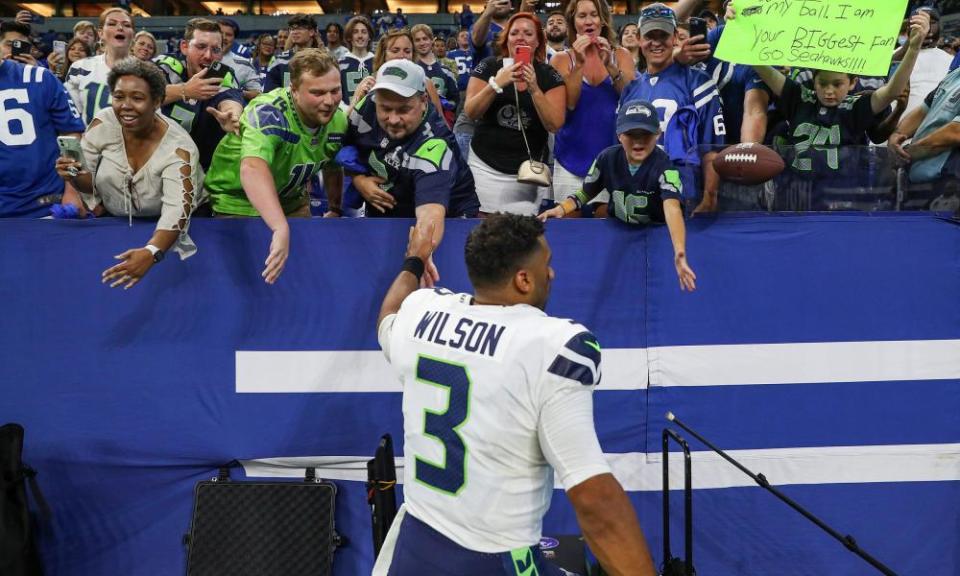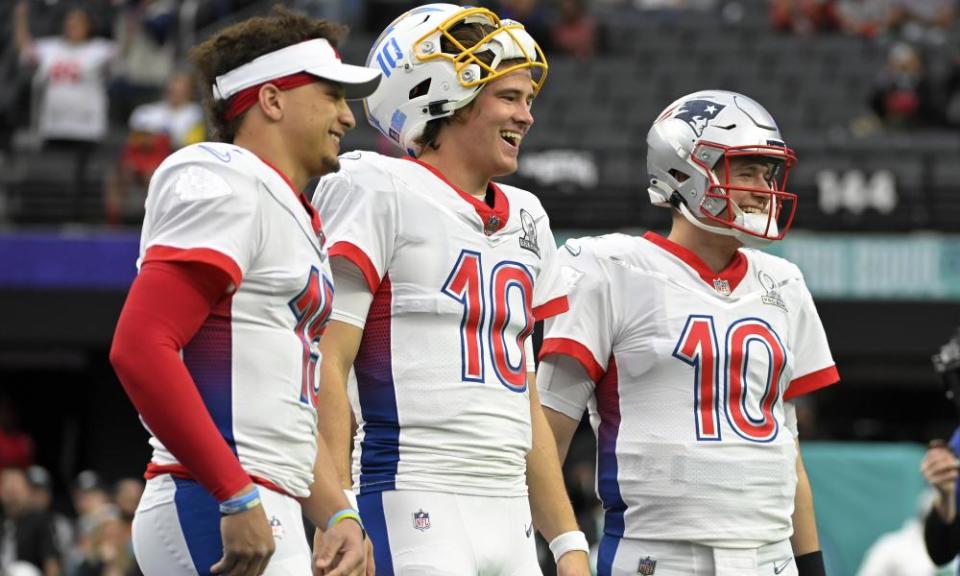Wilson, Mahomes, Herbert and Carr: is the AFC West the hardest division in NFL history?

For a while, this NFL’s offseason’s quarterback carousel barely moved. Tom Brady retired. So did Ben Roethlisberger. And despite a much-analyzed Instagram post from Aaron Rodgers that could have doubled as a retirement statement, the back-to-back MVP is staying put in Green Bay. This came after weeks of speculation that Rodgers might be headed to the very quarterback-needy Denver Broncos. Much to the dismay of Broncos fans and players, Rodgers took the sensible route on Tuesday and stayed in the city where he’s had nothing but success. And his favorite teammate is sticking around too.
So all appeared to be pleasantly boring on the quarterback front until shortly after Rodgers confirmed he was staying in Wisconsin. And then Seattle dropped a BOOM louder than any produced by their storied defenses of the mid-2010s. The Seahawks traded Russell Wilson and a fourth-round pick to the Broncos for two first-round picks, two second-round picks, a fifth-round pick, plus quarterback Drew Lock, tight end Noah Fant, and defensive lineman Shelby Harris. That, folks, is what we call a blockbuster.
There is much to dissect about the trade. Will Wilson follow in the footsteps of Peyton Manning and Brady and win a Super Bowl ring with a second franchise? Who will be Seattle’s starting quarterback? Because surely it can’t be Lock, even for one season. Will they use their newly acquired ninth overall selection on a quarterback or trade away draft picks for the rights to Deshaun Watson? Watson is clearly the biggest quarterback talent pining for a new team, but he’s also mired in serious legal troubles. Grading a trade of this magnitude is a fun exercise but, in this case, highly irrelevant given the number of draft picks involved. Just because Seattle have a recent history of mostly whiffing in the draft (see: first-rounders LJ Collier, Rashaad Penny, and Germain Ifedi), doesn’t mean that trend will continue. In truth, we may not know this trade’s “winner” for years.
Related: Chelsea fans should take one look at Woody Johnson’s Jets and be very afraid
What we do know is with Wilson’s migration to Denver, the AFC West has instantly become the NFL’s splashiest division. Franchise quarterbacks are gold and Wilson joins Patrick Mahomes, Derek Carr, and Justin Herbert for a foursome that would be hard to refute as the best divisional group in NFL history. There have been divisions stacked with star quarterbacks before – for example, the 1993 AFC East featured Jim Kelly (Buffalo), Boomer Esiason (New York), Drew Bledsoe (New England), and Dan Marino (Miami) – but not one where everyone was a star quarterback. (Jeff George, Indianapolis’s starting quarterback, was also in the AFC East that year.)

In Wilson, Mahomes, Carr, and Herbert, the division has quarterbacks that have won MVPs and Super Bowls, been in the MVP conversation, or are expected to be soon enough. The quartet has three of the top-five passing yard leaders from last season: Mahomes, Carr and Herbert combined for a whopping 14,657 passing yards in 2021. Add in Wilson, who has never had a playbook designed to let him air it out for an entire season yet has made his mark as one of the greatest magicians the NFL has ever seen. Except for Herbert, who is just getting started, these are all quarterbacks in their prime. If the NFL doesn’t douse its 2022 primetime slate with AFC West games, the league needs new schedule makers.
How Wilson adapts to the Broncos, and how they react to having their first bonafide franchise quarter since Manning retired in 2015 will be fascinating enough. But Seattle without Wilson is an unfathomable reality to grasp. Wilson has been synonymous with the city since he was drafted by the Seahawks in the third-round a decade ago.
Soon after news of the trade was made public, the Seahawks posted a now deleted tweet of the famous scene from Castaway in which Tom Hanks’s character cries out for his friend, a volleyball named Wilson, as it floats away into the deep blue ocean.
Looks like Russell Wilson isn’t the only person who no longer works for the @Seahawks
Fairly certain they just fired their social media manager too 😂 pic.twitter.com/oYA5GALWI5— Tommy G (@TommyGreturns) March 8, 2022
It was an awkward clip to post given the rawness of the news. But also because the scene perfectly encapsulates how Wilson’s departure (the quarterback not the volleyball) will affect the city of Seattle. The release of eight-time Pro Bowl linebacker Bobby Wagner hours after the Wilson trade confirmed the obvious. The Seahawks are officially in rebuild mode.
Usually, we let the dust settle before determining where a player ranks in the NFL’s pantheon. It’s one reason players are not eligible for the Pro Football Hall of Fame for five seasons once they retire.
But when it comes to the Russell Wilson Era in Seattle, the narrative is clear. Few quarterbacks have done more with less. Sure, Seattle were led by the Legion of Boom for a nice chunk of Wilson’s tenure – the Seahawks led the league in scoring defense between 2012-2015. But it was after the “boom” faded that Wilson really made his mark. He kept up his wizardry on a freakishly consistent basis, all with a perennial low-end offensive line. Doug Baldwin and DK Metcalf have been big playmakers for the Seahawks, but Wilson is the reason Seattle had been a playoff mainstay, no matter the roster or challenges. Everything fell on Wilson’s shoulders in recent years.
Now he will bring his bag of tricks to Denver. The expectations will be high but the burden will be less considering the Broncos’ solid defense and collection of young playmakers on offense. This new chapter in Wilson’s career will be rooted in comparisons to his AFC West quarterbacking brethren. And rightly so. If all four quarterbacks stay on their current trajectory, the NFL is going to need as much AFC West as possible.

